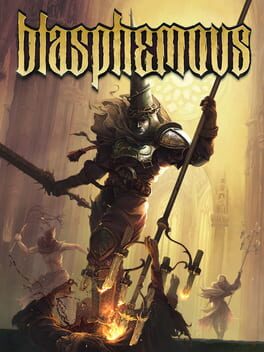The unique and evocative art of Blasphemous drew me in, and the world that kept unfolding with terrifyingly creative concepts and somber stories kept me playing it to the end. The themes about sin, suffering, and the dangerous entanglement of power and faith struck a chord with me, perhaps due to my own past struggles with religion. It seemed that the developers had detailed knowledge of this brand of Catholicism, imbuing the setting with cultural authenticity beyond just the aesthetics.
Although I must admit, the art certainly played a huge role in my enjoyment of Blasphemous. The general gameplay was fine but nothing innovative or special. The platforming wasn’t very precise, but was serviceable because most of the levels didn’t demand extreme precision. I loved the fascinating concepts for the traversal upgrades, but in practice actual movement never evolved beyond the basic jumps, wall jumps, and dashing. However, Blasphemous still excelled at the one thing that I crave most from metroidvanias: exploration.
I thoroughly enjoyed every moment I spent wandering around, losing my bearings and getting assailed by strange creatures and tortured souls in the cursed lands of Cvstodia. Every new region, enemy, and NPC were so strikingly unique and mysterious that I simply had to dive deeper and learn more about them. Even as I neared the end, I was still excited to fill out the rest of the map, backtracking to every dark corner just to see a little more of the world. It also helped that I enjoyed the combat, which was a very good 2D translation of the soulslike style.
Despite a bit of jank and some strange game design decisions, I found Blasphemous to be a unique experience much greater than the sum of its parts. It’s not the kind of game that would work for everyone, but it certainly has a strong draw with a particular audience of lore lovers and explorers.
Although I must admit, the art certainly played a huge role in my enjoyment of Blasphemous. The general gameplay was fine but nothing innovative or special. The platforming wasn’t very precise, but was serviceable because most of the levels didn’t demand extreme precision. I loved the fascinating concepts for the traversal upgrades, but in practice actual movement never evolved beyond the basic jumps, wall jumps, and dashing. However, Blasphemous still excelled at the one thing that I crave most from metroidvanias: exploration.
I thoroughly enjoyed every moment I spent wandering around, losing my bearings and getting assailed by strange creatures and tortured souls in the cursed lands of Cvstodia. Every new region, enemy, and NPC were so strikingly unique and mysterious that I simply had to dive deeper and learn more about them. Even as I neared the end, I was still excited to fill out the rest of the map, backtracking to every dark corner just to see a little more of the world. It also helped that I enjoyed the combat, which was a very good 2D translation of the soulslike style.
Despite a bit of jank and some strange game design decisions, I found Blasphemous to be a unique experience much greater than the sum of its parts. It’s not the kind of game that would work for everyone, but it certainly has a strong draw with a particular audience of lore lovers and explorers.
